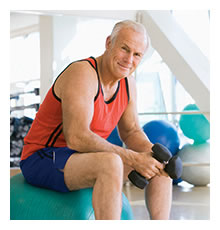

Intro to Geriatric Exercise
PTA 103L Intro to Clinical Practice 2
There are multiple theories that explain the changes to body systems with normal aging. The resulting body system impairments are well-supported in the literature and in clinical experiences. Although changes to the body systems are normal, rehabilitation and functional exercise are very effective in improving cardiovascular function, strength, agility, and flexibility in healthy older adults and those with chronic, multiple system disease.
Apply the WHO-ICF to a clinical case
WHO-ICF Case - Pneumonia





The following conditions are most commonly associated with aging and can impact functions across one or more body systems. These conditions are introduced in PTA 103, and discussed in depth in PTA 104, PTA 204, and PTA 205:
Take home points for therapeutic exercise with the older adult
Senior Fitness tests are included in Week 3 lab Prep on Conditioning and Reconditioning. Common tests include:
Other assessments of general function and fitness include:
Physiology is designed to respond and adapt to stresses within and across body systems. Excessive stress can lead to injury and disease, however, low or no stress can result in atrophy and significant or total loss of function. Stress thresholds vary across individuals, so patient monitoring and patient feedback is essential in determining appropriate overload to restore strength and function.
Physical stress is assessed by physiologic responses and patient report. Relative Perceived Exertion (RPE), such as assessed using the Borg Scale, the Talk Test, and relevant fitness tests are used to gauge appropriate stress levels to maintain or improve strength and function. Application of these assessments are discussed further in week 3 PTA 103L.

Retrieved from http://ptjournal.apta.org/content/82/4/383. 31 December 2014.
Overload is necessary to improve fitness levels.
Stress thresholds for adaptation will vary depending on "moderating factors". Examples of individual differences include:
Exercise selection should be specific for the targeted functional task, so that the speed, power, and agility needed to perform the functional activity is included in the exercise. For example: a partial squat may be used to improve strength and flexibility for sit to stand. Aerobic capacity improvements are seen with moderate to vigorous levels of exertion during sustained bouts of 15-30 minutes of exercise.

Ask and watch what the patient can do before setting limits - this will allow you to assess function and reserve and determine a true limit, versus assuming and guessing in advance of data collection
Motivation is key to engaging the older adult in exercise. It hinges on encouragement, appropriate progressions, measurable progress, and variety. It should be enjoyable and meaningful and reduce risk for injury with both exercise and functional activities.
Take a moment to listen to these active older adults. They are all "geriatric" by definition, and engage in exercise that is appropriate for their goals and includes a level of rigor consistent with maintaining and increasing strength.
Download this article on Attitudes and Expectations for an in-lab activity